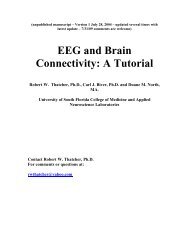Clinician's Guide - Bio-Medical Instruments, Inc.
Clinician's Guide - Bio-Medical Instruments, Inc.
Clinician's Guide - Bio-Medical Instruments, Inc.
You also want an ePaper? Increase the reach of your titles
YUMPU automatically turns print PDFs into web optimized ePapers that Google loves.
BASICS<br />
We have split the names into two parts so that you see under File Name:<br />
the animation, e.g., A1-3 Darts.scr<br />
and under Description:<br />
the remainder of the name, which includes the purpose and the band widths, e.g.,<br />
Calm Focus 3-7, 13-15, 52-58 Hz pts %-above threshold.<br />
In this way you can see the essential information about any screen at-a-glance.<br />
The name is comprised of several parts:<br />
• The letters and numbers define the essence of that screen. All of these screens can<br />
be used to “normalize” the EEG<br />
‘_AA’ will top the list because these are the assessment screens<br />
‘A’ are a set of screens for increasing calm through SMR 13-15 Hz<br />
training. (Think of Alert yet physically calm)<br />
‘B’ are a set of screens for increasing problem solving Beta 15-18 Hz.<br />
These are used in conjunction with tasks including learning and<br />
applying metacognitive strategies.<br />
‘C’ are screens for decreasing unproductive ‘busy-brain’ activity while<br />
increasing a state of Calm specific external focus or openawareness<br />
‘D’ are screens that emphasize reducing intensity (which may be anxiety)<br />
while increasing either open awareness OR a very calm state.<br />
(Think of Down-regulating intensity)<br />
‘E’ are screens that focus on the client’s ability to produce a combined<br />
mental state of calm open External awareness and readiness<br />
without interfering non-productive thoughts or anxious intensity.<br />
These screens have a wide range of uses from optimizing the<br />
performance of professional athletes, executives and advanced<br />
students to assisting clients who suffer from a number of disorders<br />
(e.g., panic, bipolar, migraine, asthma, etc) to gain self-regulatory<br />
control.<br />
‘F’ stands for “Flexibility” and “Feeling”. The client attempts to raise the<br />
given band width above threshold and hold it there and then put it<br />
below the threshold and hold it there. The client attempts to<br />
consciously understand the different metal states that raise and<br />
lower each band width. It is difficult but it is a major step in<br />
achieving ‘self-regulation’.<br />
Copyright ADD Centres Ltd. Prepublication – 1 st draft. Please do not copy. Dr. Thompson 905-803-8066 Canada 36
















